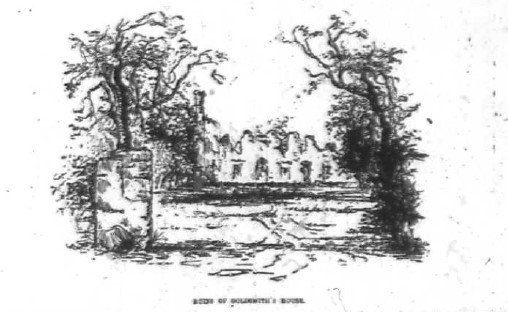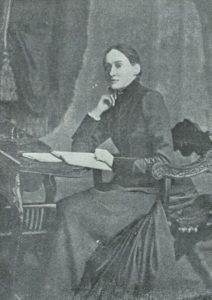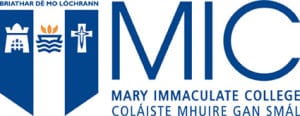Mary Banim and Goldsmith’s Country
Dr Geraldine Brassil
How to cite: Brassil, G (2024) ‘Mary Banim and Goldsmith’s Country’, IWWN Blog, date of posted entry, Available at https://irishwomenswritingnetwork.com/blog/ (Accessed date)
Kilkenny brothers and writing partners John (1798-1842) and Michael (1796-1874) Banim are described by James H. Murphy as ‘important Catholic writers.’[1] However, the name Mary Banim (c.1847-1939), the youngest of Michael Banim’s three daughters, has little resonance. She remains an obscure figure despite the fact that she was a published author and travel writer. With her sister Matilda, an illustrator, she travelled around Ireland gathering material for her travelogue. While the sisters appear to have spent formative years living in Belgium, Mary Banim proudly presented herself as an Irish woman, and one who understood and was deeply sympathetic to the regional and rural communities that she encountered on her travels.
I am interested in resituating Mary Banim as a prolific writer, social commentator and valuable contributor to contemporary print media. Her journalism illustrates a particular effort to promote a concretion of an Irish identity, kindly, intelligent and polite, that was specific to the time she was writing in and about and that challenged what she saw as a widespread misunderstanding of a country and its people under the imperial gaze. As well as her travel articles in the Weekly Freeman (reprinted in book form as Here and There Through Ireland, Parts I and II, 1891–1892), her work also provided a homeland connection for immigrant readers of the Providence Sunday Journal, (Providence, Rhode Island). Marguérite Corporaal has explored ‘the Atlantic as a trope and pathway of mnemonic transmission through which regional values can be disseminated to communities abroad’.[2] And Mary Banim may have seen her vignettes of local colour and descriptions of Irish life as having a similar function. Glenn Hooper has argued that ‘[t]he nineteenth century was stamped by the rhetoric of empire, and many of its travellers mirrored, and in some cases passionately articulated, empire politics’.[3] While Banim, an Irish woman travelling around Ireland, acknowledged evident poverty and hardship, her purpose was straightforward: it was simply to present an empathetic, positive and more accurate image, as she saw it, of Irish people, culture, history and tradition. Banim’s female gaze was directed towards the local and the transnational, offering her readers an eye-witness image of Ireland and an Irishness that countered colonial views.

Figure 1: Banim, M.E., ‘Ruins of Goldsmith’s House’, Illustration in Banim, Mary, ‘Here and There Through Ireland’, Second Series, ‘Sweet Auburn’, Chapter XIV, Weekly Freeman 17 January 1891, p. 9. Image Courtesy of the National Library of Ireland.
An example of Banim’s cultural nationalism comes to the fore in her articles (with illustrations by M.E. Banim) on Oliver Goldsmith’s boyhood home in Ireland, Lissoy. These were first published in the Weekly Freeman from 17 January 1891. Articles on Goldsmith’s country also appeared in the Providence Sunday Journal in February, March, and April of 1891; however, M.E. Banim’s sketches were not included. For years Mary Banim had longed to see Lissoy, the place so loved by Oliver Goldsmith. Now sharing knowledge garnered on her travels, in her articles she advises ‘tourists’ to secure the guidance of Mr Mac, a County Westmeath man, and proprietor of ‘the principal posting establishment in Athlone’.[4] Noting that he was ‘born and reared in the very neighbourhood where Goldsmith lived in youth’, she describes their cheery and chatty ‘conductor’ on a leisurely drive through the area.[5] Mr Mac, according to Banim, ‘naturally knows more about things than those who never tickled trout in the Inny in boyhood or never trod one foot of ground around Auburn’.[6] Using the language of belonging, Banim goes on to ask a leading question: ‘What do you think the English write about your Auburn Mr Mac?’.[7] Highly indignant that outsider commentators were of the opinion that Goldsmith’s ‘Auburn’ could not have been inspired by the Irish countryside, Mr Mac makes a series of rhetorical statements: ‘“What do you think they say! They say it was not Ireland or Irish village life that Goldsmith pictured in his poem. That there is no such country here; there are no such villages; not even such wildflowers”’.[8] Through Mr Mac’s words Banim makes her point succinctly, simultaneously sending a message that is rooted in Irish cultural nationalism to her readers, at home and abroad
“Arrah! – (And the world of meaning that can be put into that one word). Arrah! – Here’s how it is with them in one short chapter: – they do be talkin’. There’s the whole of it, now. Them people that are forever writin,’ they must be for ever sayin’ something, and they can’t stop themselves, whether they know what they’re sayin’ or no. They must be layin’ down the law ― England! Country – villages – flowers!! Just turn your heads, ladies –what garden in the world could grow anything to equal them”.[9]
Banim muses, ‘“Mr Mac is large and stout and well – not a boy”, thought I; “but trust him to see what is beautiful”’.[x] In many ways, Mary Banim projects her ideal of Ireland through Mr Mac who ‘seems to draw fresh life and joy with every breath, and looks around with love and pride beaming in his face, a word for everyone we meet, a greeting at every cottage door, an occasional outburst of: – “There’s land! But wait, wait till you see the country around Ballymahon!”’.[xi]

Figure 2: Banim, M. E, ‘The Bawn, Athlone’, Illustration in Banim, Mary, ‘Here and There Through Ireland’, Second Series, Chapter XII, Weekly Freeman, 15 November 1890, p. 9. Image Courtesy of the National Library of Ireland.

Figure 3: M.E. Banim ‘“Goldsmith’s Mound”. From the Gate of Goldsmith’s House, Lissoy’. Illustration in Banim, Mary, ‘Here and There Through Ireland’, Second Series, ‘Sweet Auburn’, Chapter XIV, Weekly Freeman, 24 January 1891, p. 9. Image Courtesy of the National Library of Ireland.
In her ‘re-reading or re-visioning of Asenath Nicholson’s famine account’, Margaret Kelleher argues that eyewitness narratives of the period ‘constitute a significant but frequently neglected historical source’.[xii] Such texts, Kelleher asserts, ‘deserve a close examination, moving beyond questions of putative accuracy to the type of detail chosen for representation, the existence of recurring motifs, the role of the observer and the creation of a famine spectacle’.[xiii] Mary Banim’s project was to connect with Irish heritage, history and folklore; to embrace and promote a distinctly Irish identity and to present a positive image of Ireland, its people and places. Yet her name is not associated with Revivalism or ideas of literary greatness. Her local profile and her transatlantic periodical presence merits, however, a revaluation and a resituating of her work.[xiv] Banim reached local and diasporic communities with her articles based on a collective Irish identity, her observer accounts adding extra layers to a much broader understanding not only of nineteenth-century regional and rural communities, but, just as importantly, of the work practices and concerns of the Irish woman travel writer.
Dr Geraldine Brassil, Mary Immaculate College, Limerick
Geraldine Brassil is a postdoctoral researcher. She held a Teaching Fellowship with the Department of English Language and Literature, Mary Immaculate College, Limerick, 2023-2024. In December 2022, she successfully defended her PhD thesis. As a PhD student she was awarded an IRC 2020 Government of Ireland Postgraduate Scholarship. Her work focuses on the study and recovery of nineteenth century Irish women writers and evolving print cultures in contemporary publishing contexts. She is an assistant researcher with the Irish Women’s Writing (1880-1920) Network.
Bibliography
Banim, Mary, ‘Here and There Through Ireland: Second Series, By Mary Banim. With Illustrations by M.E. Banim, Chapter XII – (continued), Weekly Freeman, 15 November 1890.
Banim, Mary, ‘Here and There Through Ireland: Second Series, By Mary Banim. With Illustrations by M.E. Banim: ‘Sweet Auburn’, Chapter XIV – (continued), Weekly Freeman, 17 January 1891.
Banim, Mary, ‘Here and There Through Ireland: Second Series, By Mary Banim. With Illustrations by M.E. Banim: ‘Sweet Auburn’, Chapter XIV – (continued), Weekly Freeman, 24 January 1891.
Brassil, G. (2023), ‘Women’s Collaborative Literary Processes and Networks: Mary and Matilda Banims’ Ireland’, English Studies, published online: 20 November 2023.
Corporaal, M. (2021) ‘“Where the Atlantic meets the land”: the ocean as regional and transnational space in Irish (diaspora) local colour fiction of the 1890s’, Nineteenth-Century Contexts, 43(3), pp. 349–368.
Hooper, Glenn., ed., (2001), The Tourist’s Gaze: Travellers to Ireland, 1800-2000, Cork: Cork University Press.
Kelleher, Margaret, “The Female Gaze: Asenath Nicholson’s Famine Narrative”, in Fearful Realities: New Perspectives on the Famine, C. Morash and R. Hayes, eds, Blackrock: Irish Academic Press, 1996:119-30.
Murphy, James. H. (2011), Irish Novelists and the Victorian Age, Oxford: Oxford University Press.
[1] Murphy, J.H., (2011), Irish Novelists and the Victorian Age, Oxford: Oxford University Press, p. 9.
[2] Corporaal, M. (2021): “Where the Atlantic meets the land,” p. 351.
[3] Hooper, G., ed., (2001), The Tourist’s Gaze: Travellers to Ireland, 1800-2000, p. xxiii.
[4] Banim, M., Here and There Through Ireland: Second Series, Chapter XII, Weekly Freeman, 15 November 1890.
[5] Banim, M., ‘Here and There Through Ireland: Second Series: Sweet Auburn, Chapter XIV’ Weekly Freeman, 17 January 1891, p. 9.
[6] Banim, M., Weekly Freeman, 17 January 1891, p. 9.
[7] Banim, M., Weekly Freeman, 17 January 1891, p. 9.
[8] Banim, M., Weekly Freeman, 17 January 1891, p. 9.
[9] Banim, M., Weekly Freeman, 17 January 1891, p. 9.
[x] Banim, M., Weekly Freeman, 17 January 1891, p. 9.
[xi] Banim, M., Weekly Freeman, 17 January 1891, p. 9.
[xii] Kelleher, M., “The Female Gaze”, 119.
[xiii] Kelleher, M., “The Female Gaze”, 119.
[xiv] See Brassil, G., ‘Women’s Collaborative Literary Processes and Networks: Mary and Matilda Banims’ Ireland’, English Studies, published online: 20 November 2023.



